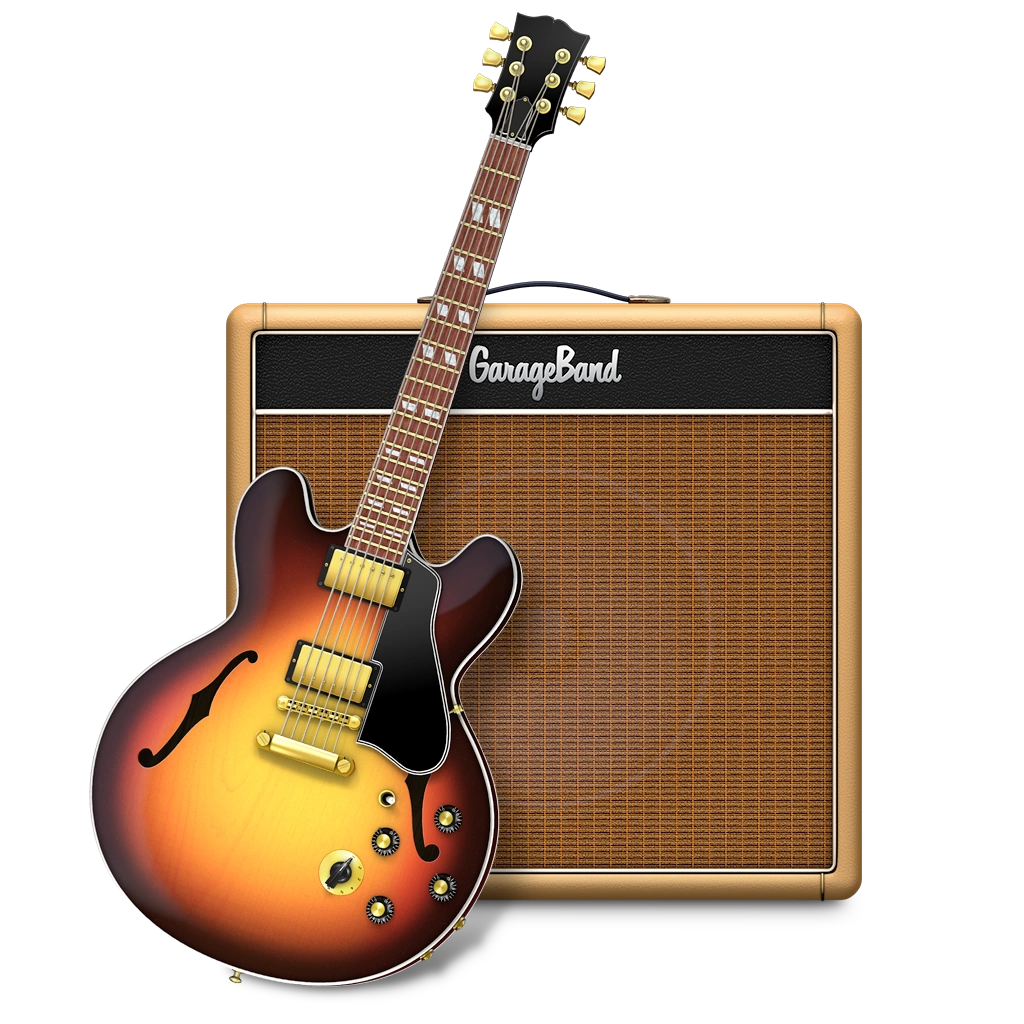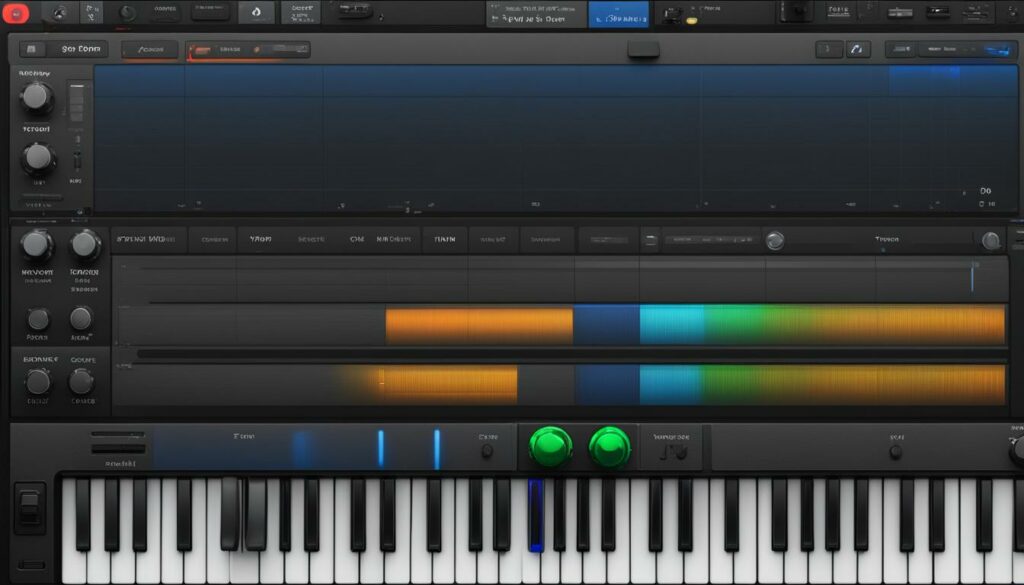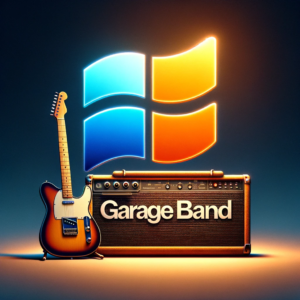As enthusiastic creators in the realm of digital audio, we’ve all explored the potential of GarageBand to bring our musical visions to life. Yet, there comes a time when our tracks call for a quick tempo increase in GarageBand, compelling us to delve into the intricacies of GarageBand tempo control. Mastering how to speed up tempo in GarageBand not only elevates the energy of our compositions but also opens up a world of rhythmic possibilities.
In the quest for pacing perfection, we’ll guide you through a seamless process that harmonizes your music with your creative pulse. Prepare to harness the full power of tempo manipulation in GarageBand, and let’s amplify the beat of your next hit together.
Understanding Tempo in GarageBand
When we embark on crafting a melody in GarageBand, the tempo—measured in beats per minute (BPM)—serves as the heartbeat of our creation. Defaulting to 120 BPM on a new GarageBand project, the tempo is a crucial component that dictates the pace and rhythm of our musical narrative. Whether speeding up the tempo in GarageBand for an energetic chorus or slowing it down for a poignant bridge, tempo mastery is key to resonating with our intended audience.
The beauty of GarageBand tempo adjustment lies in its flexibility to suit various musical styles, allowing us to shape the groove and flow of our tracks. From the sway of a soft ballad to the punch of an up-tempo dance track, comprehending the BPM’s impact is instrumental in honing our projects. And with the ability to increase tempo in GarageBand, we possess the power to inject vitality and urgency into our musical compositions.
Integrating tempo variations not only tailors the track to align with genre conventions but also serves as a creative tool to accentuate the emotional gravity or light-heartedness of a piece. Be it a subtle increase for a climactic section or a dramatic shift for creative flair, the tempo we set can ultimately transform the listener’s experience of our music. As we traverse the path of audio editing within GarageBand, we come to appreciate the profound role tempo plays in the realm of digital composition and audio storytelling.
The Basics of Changing Project Tempo
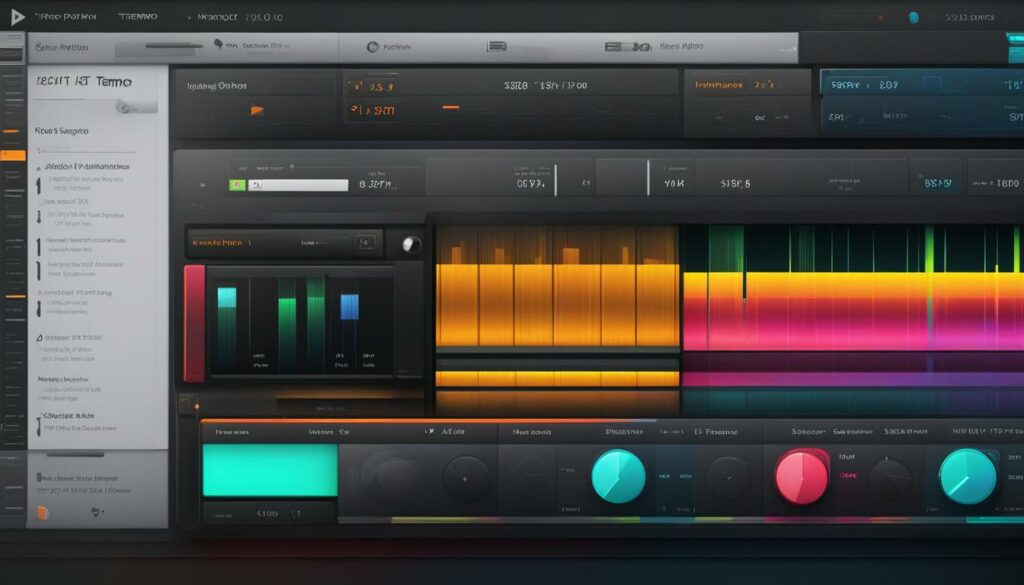
When we work within GarageBand, understanding how to adeptly change the project tempo is central to crafting our musical pieces. Those pivotal moments when our tracks demand an alteration in pace, our knowledge of locating tempo settings and executing precise tempo adjustments becomes invaluable.
Locating the Tempo Settings
The first step in modifying BPM GarageBand requires us to navigate the interface to locate the tempo settings. We’ll find the project tempo display nestled between the playhead position and the song’s key signature in the menu bar. This intuitive placement allows us to access and change project tempo with ease.
How to Modify the BPM for Your Entire Project
When we decide to enact a project-wide tempo adjustment, we simply double-click on the project tempo display. Here, we can type in the new BPM value and watch as our entire project aligns with this fresh tempo. Alternatively, dragging the tempo with the cursor offers a more tactile approach, granting us the ability to make incremental, yet significant changes to our song’s rhythm.
Using the Tempo Track for Precision
For those times when a piece requires a more nuanced approach, using the tempo track in GarageBand is our go-to tool. By accessing this feature via the menu bar or by employing the SHIFT + COMMAND + T keyboard shortcut, we can create and manipulate multiple tempo points. This level of precision tempo adjustment empowers us to either ramp up the energy in a chorus or introduce a reflective pause in a verse with exactitude, thereby enhancing the song’s dynamics and emotional depth.
Our mastery of tempo manipulation allows us to breathe new life into our musical creations. The built-in tempo track features endows us with the flexibility and control necessary to realize the precise pacing our music demands, ultimately contributing to the unique sound that defines our artistic voice.
Adjusting Tempo for Individual Segments
Within the dynamic landscape of GarageBand, we often find ourselves needing to tailor the rhythm to suit distinctive segments of our musical compositions. This is where the granularity of adjusting tempo for segments becomes an integral aspect of music production. It’s not just about the overall tempo; it’s about ensuring each piece of the puzzle fits the emotional tone and narrative of the song.
Let’s focus on how we utilize the Tempo Track feature within GarageBand to achieve individual track tempo adjustment. GarageBand makes it possible to introduce segment-specific BPM changes that can profoundly influence a track’s expressiveness. Whether it’s for a single dramatic break or a smooth transition, manipulating the tempo for particular portions adds depth and character to our music.
In practice, we initiate this process by placing new tempo points along the Tempo Track where we desire the alteration to commence. By clicking and dragging these points, we orchestrate the tempo changes delicately, ensuring a seamless blend with the surrounding measures. The result is a targeted pace modification that can make a chorus soar or introduce a thought-provoking slowdown in a bridge.
Embarking on segment-specific BPM change is not just a technical task—it’s an art form that enhances the narrative of our music. It’s a journey through the rhythms that can evoke excitement, suspense, or serenity within our projects. Here’s to creating moments in our tracks that pulse with just the right pace, capturing our listeners’ hearts and minds.
Accelerating Tempo Using the Tempo Track
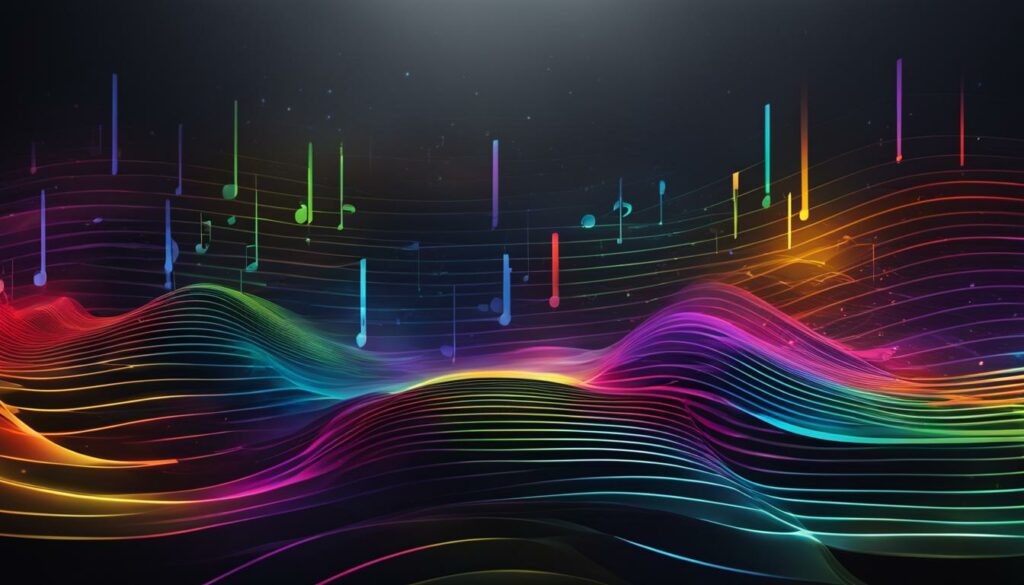
When we seek to invigorate our music with a rhythmic surge, accelerating the tempo in GarageBand proves to be a formidable ally. The ability to increase tempo with automation equips us with the agility to create dynamic shifts that can elevate the emotional impact of a piece. Let’s explore how to harness the power of the Tempo Track for precisely timed tempo accelerations within our projects.
Using the Tempo Track is akin to conducting an orchestra; we dictate the pace and the musicians—our digital instruments—respond in kind. It begins with placing strategic tempo points along the Tempo Track. These points act as markers, signifying where we intend to inject a burst of speed or transition into a more measured beat. To speed up a section, we simply grab these points and drag them upwards, watching the BPM rise and feeling the pulse of the track quicken beneath our fingertips.
The brilliance of the Tempo Track is its flexibility. With the addition of automation points, we can navigate a song’s landscape with precision, making subtle increases in tempo that build anticipation or lead into a celebratory chorus. The audacity of a sudden tempo leap or the grace of a gradual crescendo both lie within our reach. With these tools, our compositional canvas expands, allowing us to paint with wide, significant strokes of pace and rhythm.
As we sculpt the sonic architecture of our songs, we’re not merely making technical adjustments; we’re weaving a tapestry of momentum. Through the meticulous adjustment of the Tempo Track’s points, our music accelerates, not just in speed, but in excitement and expectancy. It’s a testament to how using tempo track to speed up segments can enrich the narrative woven by our melodies and harmonies.
Tempo Alteration: A Tool for Creative Expression
Embracing tempo alteration creativity serves as a pivotal element for us, the music creators, to express our artistic vision. The tempo of a piece is not just a number—it’s the pulse that gives life to our musical ideas, influencing how listeners feel and interact with our creation. As we journey through the realms of right tempo for music genres, we encounter the significance of BPM guidelines for genres.
Identifying the Right Tempo for Different Music Genres
Each genre of music carries its own rhythmical identity, one that resonates with its cultural and stylistic origins. To craft a piece that stays true to a genre, we meticulously consider the BPM range that defines it. Reggae, for instance, flows effortlessly between 60 and 90 BPM, encapsulating its laid-back and groovy essence. A hip-hop track would likely find its groove with a BPM from 85 to 115, allowing for a smooth flow of rhymes over beats.
When it’s our ambition to create an impacting pop tune, the BPM can range from a danceable 100 to a more vibrant 130. In contrast, R&B’s soulful and smooth nature calls for a slower pace, typically between 60 and 80 BPM. Rock, with its vast sub-genres, can span from an energizing 110 to a heart-thumping 140 BPM, while metal pushes further into intensity with BPMs stretching from 100 to a thunderous 160.
Moving to the electronic spectrum, house music thumps steadily between 118 and 135 BPM, creating that unmistakable four to the floor heartbeat. Similarly, UK Garage hovers around the same spectrum, primarily at 130 to 135 BPM. Techno, embracing minimalism and repetitive beats, can vary widely from 120 all the way up to 160 BPM. And for those daring to venture into high-energy dance genres such as Drum and Bass, the tempo kicks into high gear, pulsing between 165 to 185 BPM.
Latin genres such as salsa ignite the dancefloor with exhilarating tempos ranging from 180 to a breathtaking 300 BPM. Samba, with its Brazilian roots, maintains a more moderate, yet no less captivating, pace at 96 to 104 BPM. Recognizing these BPM guidelines for genres is not simply about adherence but about understanding the foundational tempo that gives each music genre its distinctive character and charm.
In our legion of sound and silence, tempo is our navigator, and with GarageBand at our fingertips, we hold the key to unlocking boundless rhythmic territories. Through subtle tempo alterations or sweeping accelerations, our music has the power to traverse genres, emotions, and atmospheres. Thus armed with insight and technology, we continue to metamorphose our sonic landscapes, firmly embedding tempo alteration as a core facet of our creative expression.
GarageBand for Windows: Accessing Tempo Tools
For music enthusiasts and content creators eager to exercise nuanced control over their audio projects, the quest to access tempo tools similar to those in GarageBand on a Windows platform is a common one. While an official GarageBand for Windows does not exist, our community of audiophiles often seek out methods to apply the beloved features of Apple’s DAW on alternative systems. Here’s where our journey into the world of tempo adjustment on Windows begins.
In our shared pursuit of sonic perfection, the ethos remains the same, even as we transition from macOS to Windows: we strive to manage tempo adeptly, moulding the beat to match our vision. While Windows users can’t access the native GarageBand application, there are still plenty of avenues to explore for Windows GarageBand tempo adjustment. It’s about understanding the core principles of tempo control and then applying that wisdom to compatible software on the Windows platform.
Our collective knowledge of tempo manipulation remains universal, translatable across different software environments. By seeking out third-party applications that embody similar functionalities, we can still orchestrate our music with the intricate tempo variations that GarageBand offers on macOS. Our drive to adjust the tempo of our tracks—a planned sprint through the energetic chorus or a purposeful decrescendo into a thoughtful bridge—doesn’t fade with the shift in operating systems.
We understand the pulse of music is essential, and so even without GarageBand at our disposal on Windows, we employ other DAWs that grant us the power to control it. From free software that emulates the basic features to more advanced digital audio workstations, the tempo tools we need are within reach. It’s up to us to plunge into these resources, acquaint ourselves with their mechanics, and command the rhythm of our creations as adeptly as we would in GarageBand on a Mac.
While we may not be able to access GarageBand for Windows directly, we’re not disheartened. We’re resourceful and adaptive, finding our tempo-focused melody within alternate but equally effective software tools. In the end, it’s not the platform that defines our music, but our unyielding desire to shape it artfully, with precision and intent.
Speeding Up Audio Files with Flex Time
When it comes to speeding up audio files, we find that innovation in audio editing tools like GarageBand transforms the complex into the simple. Specifically, the advent of Flex Time in GarageBand has empowered us with the ability to intricately manipulate the timing of our audio tracks with a level of precision that was once a fanciful dream.
At the core of this tool’s prowess is a feature that allows us to micro-manage the very fabric of our audio files: the transients. These transients are the acoustic markers, the strong attack points that punctuate the audio wave and define its rhythmic content. With Flex Time activated, we gain control over these markers—affording us the dexterity to compress or expand audio regions. This, in turn, is what facilitates the tempo manipulation necessary to breathe new life into a track.
Here’s how we harness Flex Time for our creative endeavors:
- First, we initiate Flex Time by clicking ‘Enable Flex’ in the audio editor pane—our gateway to temporal control.
- Next, flex markers appear around the transients. By carefully adjusting these markers, we nudge the audio forward or draw it back, hence speeding up or slowing down sections as required.
- It’s a dance of push and pull with the waveform, where we orchestrate tempo changes without disrupting the entire track.
Our mastery over this realm of time stretching allows us to approach tempo alteration with finesse and artistry. We’re not merely changing speeds; we’re contouring the texture and timing of our soundtrack—crafting a rhythmic narrative that aligns with our creative vision while ensuring sonic fidelity.
And so, when we think of speeding up audio files, we don’t just see a button to press or a knob to turn. We see an opportunity to fluently converse with our music, guiding it to quicken its pace where the story we’re telling needs a swift and spirited stride.
With sectors of sound under our command through Flex Time in GarageBand, we craft audio masterpieces that march to the beat of our drum, swaying in tempo as we dictate, all while preserving the integrity of the original composition. It is through such tempo manipulation that our music finds its true pace, painting pockets of urgency or relaxation in the vast canvas of our auditory art.
Practical Tips for Effective Tempo Adjustment
As we refine our craft in digital music production, effective tempo adjustment in GarageBand plays a pivotal role in achieving the desired outcome of our tracks. One critical aspect that requires our attention is avoiding pitfalls in GarageBand when it comes to speeding up our creations. Let’s share some essential tips to ensure the process enriches our music without compromising its quality.
Avoiding Common Pitfalls When Speeding Up Tracks
To speed up tracks cautiously in GarageBand is to preserve the integrity of our sound. When applying tempo changes, it is important to be aware of the risks associated with over-compression. This can lead to a significant decrease in audio quality and may even cause system problems that interrupt our creative flow. To navigate around these obstacles, it’s essential to follow a mindful approach during the editing phase.
Flex Time is a marvel in modern music editing within GarageBand, allowing us to make precise tempo manipulations. However, we must handle flex markers with care. Mismanagement of flex markers when attempting to increase the tempo can result in unnatural audio artifacts or timing discrepancies that jar the listener’s experience. By carefully adjusting flex markers, we maintain the rhythmic essence of our audio, ensuring each beat fits organically into the new, accelerated pace.
Moreover, when working with imported audio loops, we must consider that the tempo of each loop is fixed to its original BPM. In speeding up these loops, we must respect their intrinsic properties to avoid phase issues or unwanted stretching. If the need arises to adjust the tempo of such loops, it’s advisable to do so within a new project, matching the loop’s inherent tempo before integrating it back into the main composition.
Ultimately, the goal is not just to speed up the audio but to enrich the track with a well-measured pace. By applying an understanding of GarageBand’s capabilities and restrictions, we elevate the tempo without triggering the pitfalls that could detract from the professional touch of our music. It’s about a delicate balance between timing and quality—a balance on which the success of our auditory adventures often hinges.
Advanced Tempo Control Through Automation Curves
In the realm of music production with GarageBand, we often aspire to reach beyond basic editing tools, exploring advanced tempo control mechanisms that can dramatically elevate the dynamics of a track. The utilization of automation curves in GarageBand exemplifies just how nuanced and rich these editing experiences can be. As we weave complex rhythmic patterns through our compositions, the ability to apply precise tempo adjustments over time becomes ever more essential.
Like a painter who mixes shades with deft strokes for the perfect hue, we too blend fluctuations in tempo to create the auditory equivalent of a masterpiece. By strategically positioning automation points on the Tempo Track, we execute gradual escalations or decrescendos in tempo with surgical precision. This facility to sculpt the pace of our music unveils a spectrum of storytelling possibilities that resonate with listeners on a deeper level.
Whether we’re looking to inject a brisk sense of urgency in a high-energy workout track, or a tapering slowdown for a reflective ballad, the power lies at our fingertips. With each tempo point we establish on this track, we’re effectively plotting a course for our song to follow—a course that can seamlessly transition from mellow introspection to fervent climax without missing a beat.
One might wonder, how do we harness such potent functionality for our artistic ends? In GarageBand, accessing the Tempo Track is trivial but optimizing its potential is an art. Here’s a glimpse into how we proceed:
- We activate the Tempo Track, revealing a timeline where our song’s rhythm unfolds.
- As the song progresses, we drop in automation points—each a marker for a tempo shift.
- We then drag these points, crafting an arc or valley in the tempo curve to signify acceleration or deceleration.
- Throughout this process, our control remains unerring, aware that each tweak reflects directly in the tempo felt by the listener.
Indeed, this advanced capability to modulate tempo isn’t merely about alteration—it’s an exploration of rhythm’s potential to shape experience. It’s here, within GarageBand’s sleek interface, that our music breathes, ebbs, and flows in rhythm with our creative impulses.
We embrace the automation curves in GarageBand, not just as a feature, but as an extension of our musical lexicon. Through them, precise tempo adjustments become not just possible but instinctual. It’s as if our music itself learns to inhale and exhale, pulsing to the beat of our ingenuity and the tempo of our shared human experiences.
Alternatives to GarageBand for Tempo Modification
As we deepen our understanding of music production, we often reach a point where the built-in features of GarageBand, while powerful, may not fully cater to our evolving needs. Particularly when it comes to tempo modification, we find ourselves in search of alternatives to GarageBand that provide a more nuanced and flexible approach to time-stretching and rhythm adjustments. This is where third-party tempo modification tools and software come into play, extending the capabilities beyond the foundational offerings of GarageBand.
One robust alternative is Logic Pro X, a professional-grade software that inherits the user-friendly interface of GarageBand but with an extended arsenal of tempo manipulation tools. It offers sophisticated features like Smart Tempo, which provides seamless tempo mapping and editing without the steep learning curve one might expect from a pro-level DAW.
For those who may not have access to macOS, or who prefer a cross-platform application, Audacity serves as a reliable and free alternative. It offers essential time-stretching features that allow us to adjust tempo without altering the pitch, giving us the freedom to modify the pace of a track while preserving its original tonal quality.
An additional powerhouse in the realm of tempo control is Melodyne. Renowned for its pitch correction capabilities, Melodyne also shines in the precise temporal manipulation of audio. With its ability to detect and edit the timing of individual notes within a polyphonic texture, Melodyne stands out as an invaluable tool for complex time-stretching tasks that GarageBand cannot handle natively.
Moreover, incorporating a GarageBand plugin can address specific needs and expand the software’s functionality. Plugins like Flex Pitch and Time in Logic Pro X are also available for GarageBand through the AU (Audio Unit) extension, thereby enhancing its usability for detailed tempo and pitch work.
In our journey as creators, we are not limited by the boundaries of a single application. We actively explore and integrate third-party tempo modification software and plugins to expand our musical toolkit. As we progress in our craft, these alternatives to GarageBand enable us to continue composing and producing with the sophistication and precision our projects demand.
Wrapping Up: Saving and Sharing Your Faster Tracks
As we reach the crescendo of our music editing journey, the focus shifts to saving faster tracks in GarageBand. This pivotal step guarantees that all our meticulous tempo adjustments are securely preserved in the project file. Saving not only safeguards our creative input but sets the stage for sharing our work—ushering our accelerated music into the world to be experienced by eager listeners.
Upon finalizing tempo adjustments, it’s essential to save our project, capturing the high-octane essence that we’ve woven into every beat and bar. GarageBand’s user-friendly interface makes this step a hassle-free endeavor, allowing us to spend less time on technicalities and more on our artistic pursuits. What follows saving is the excitement of sharing accelerated music, and GarageBand facilitates this with simplicity, offering a range of export options to fit various formats and platforms, ensuring our listeners receive the high-velocity hits in impeccable quality.
Our musical narratives, now pulsing with newfound speed and vitality, are ready to make their mark. Whether they’re destined for streaming platforms, social media, or intimate listening sessions, our finalized tempo adjustments are set to thrill and invigorate audiences. With GarageBand as our steadfast companion along the rhythmic road, we invite the world to share in the dynamic tracks we’ve crafted, confident that the energy we’ve poured into each note will resonate far and wide.
FAQ
How do I speed up the tempo within my GarageBand project?
To speed up the tempo, you need to access the tempo settings in the LCD section of the GarageBand interface and adjust the BPM to the desired speed. You can directly input the new BPM or drag the tempo indicator up to increase the tempo for the entire project.
Where can I find the tempo controls in GarageBand?
Tempo controls are easily accessible in the LCD section at the top center area of the GarageBand window, situated between the playhead position and the key signature. Look for the number that represents the current BPM of your project.
Can I change the tempo of only a specific section of my GarageBand track?
Yes, you can change the tempo of particular sections using the Tempo Track. Create tempo points at the start and end of the section you want to adjust, then drag these points to increase the BPM as needed.
What is the Tempo Track, and how do I use it in GarageBand?
The Tempo Track in GarageBand allows you to make detailed tempo adjustments throughout your project. It can be accessed from the ‘Track’ menu. Add tempo points by clicking on the Tempo Track and drag them to change the BPM for specified sections of your project.
How do I accommodate different music genres with tempo changes in GarageBand?
Adapting to different music genres involves selecting a BPM within the typical tempo range for that genre. Refer to the standard BPM guidelines and listen to genre examples as a gauge for your tempo adjustments.
Is there a GarageBand version for Windows that I can use to adjust tempo?
Officially, GarageBand is only available for macOS and iOS. For Windows PC users wanting to adjust tempo, alternative software options are recommended, such as LMMS or Cakewalk, which also provide tempo control features.
How can I use Flex Time to speed up only a part of my audio file?
Activate Flex Time by clicking on the Flex button and then adjust the timing of individual notes or beats within an audio region. Dragging the flex markers to the left will compress the audio and effectively speed it up.
What are some common pitfalls to avoid when speeding up tracks in GarageBand?
When speeding up tracks, be cautious not to overdo it as this can distort the audio or cause timing issues. Use features like Flex Time carefully and pay attention to the rhythm to prevent your audio from sounding unnatural.
Can I make precise tempo changes in GarageBand using automation curves?
Yes, you can use automation in the Tempo Track to create gradual and precise tempo changes. This can be achieved by adding and adjusting tempo points, which act as automation curves for subtle transitions.
What alternatives to GarageBand can I explore for more advanced tempo modification?
If you need more advanced tempo modification features, you might want to explore software such as Logic Pro X, Pro Tools, or Ableton Live, which offer extensive tools for time-stretching and tempo manipulation.
What should I do after I’ve achieved the desired tempo increase for my GarageBand project?
Once you’ve made your tempo adjustments, ensure you save your project to lock in those changes. You can then export your track to share your music with listeners, reflecting the new, faster tempo you’ve set.
